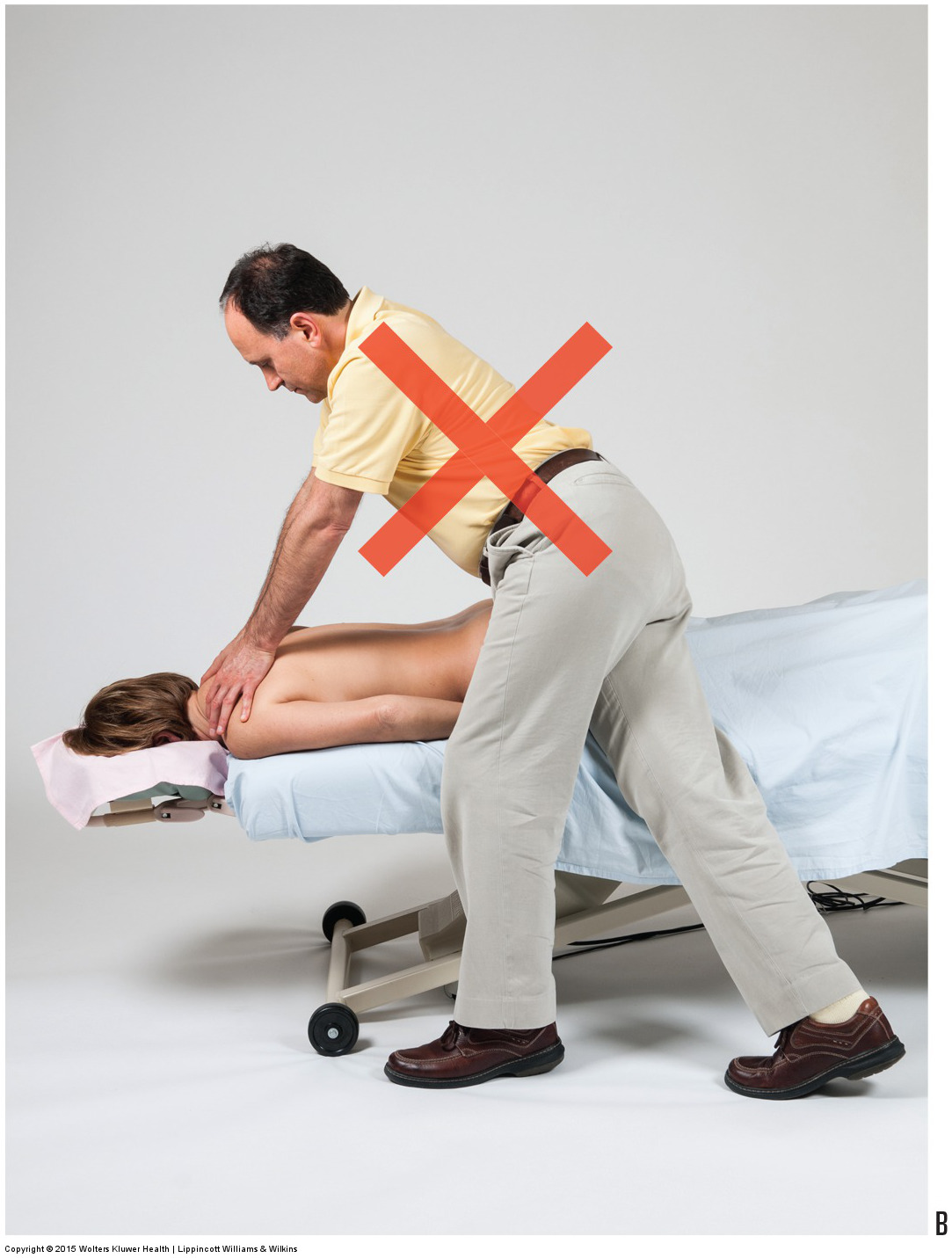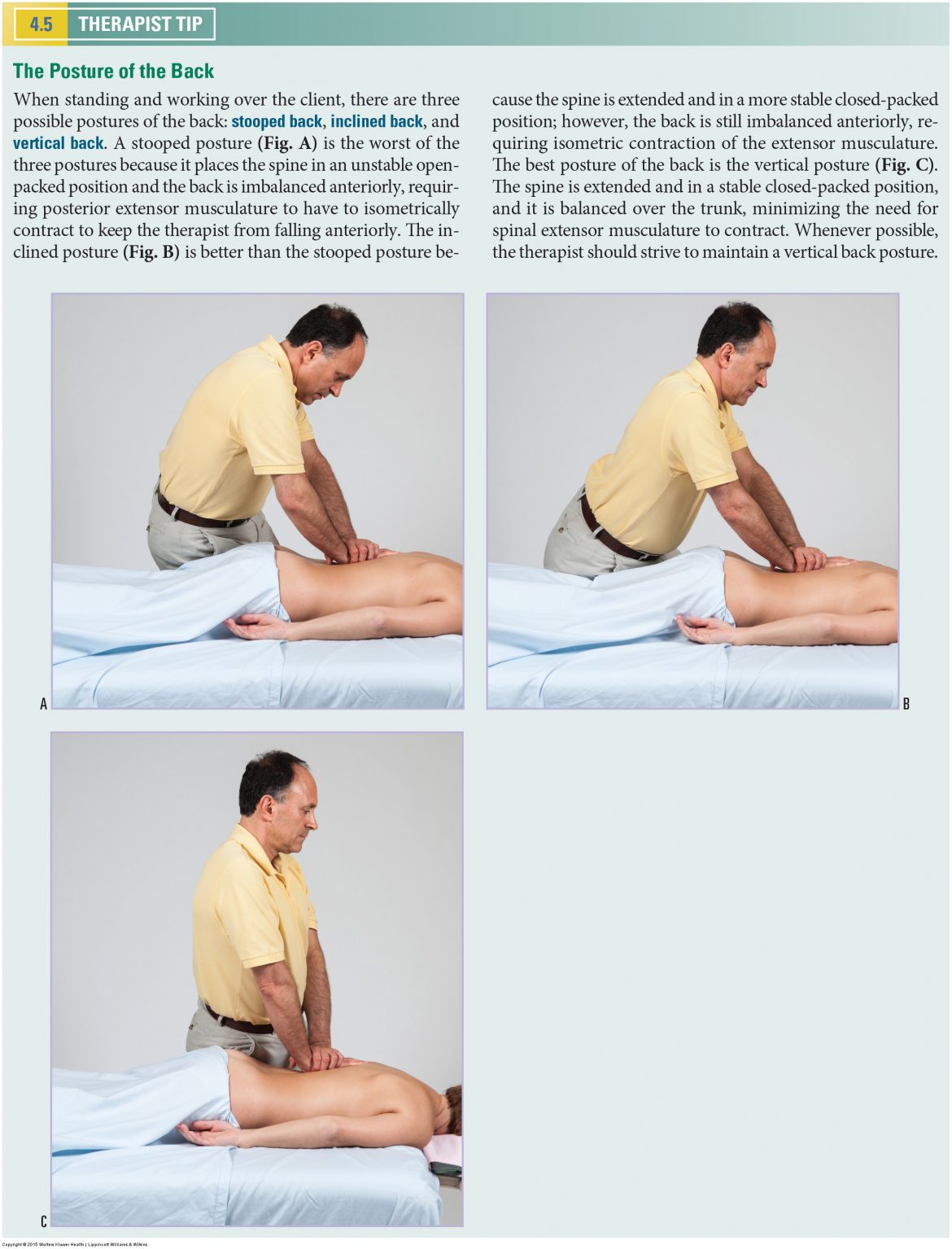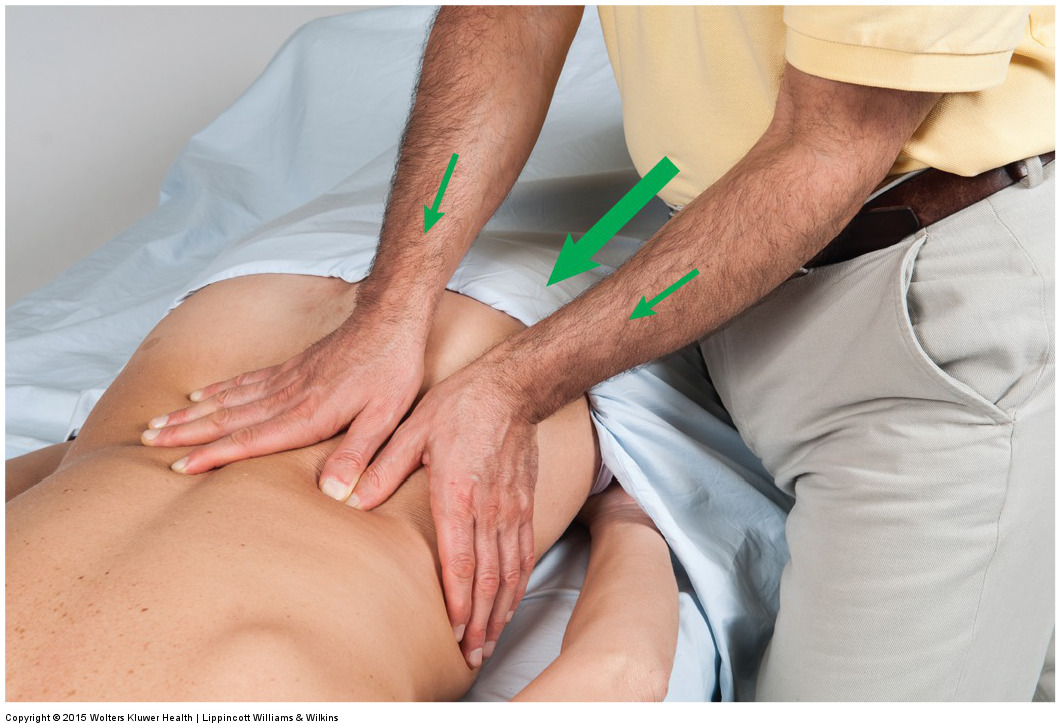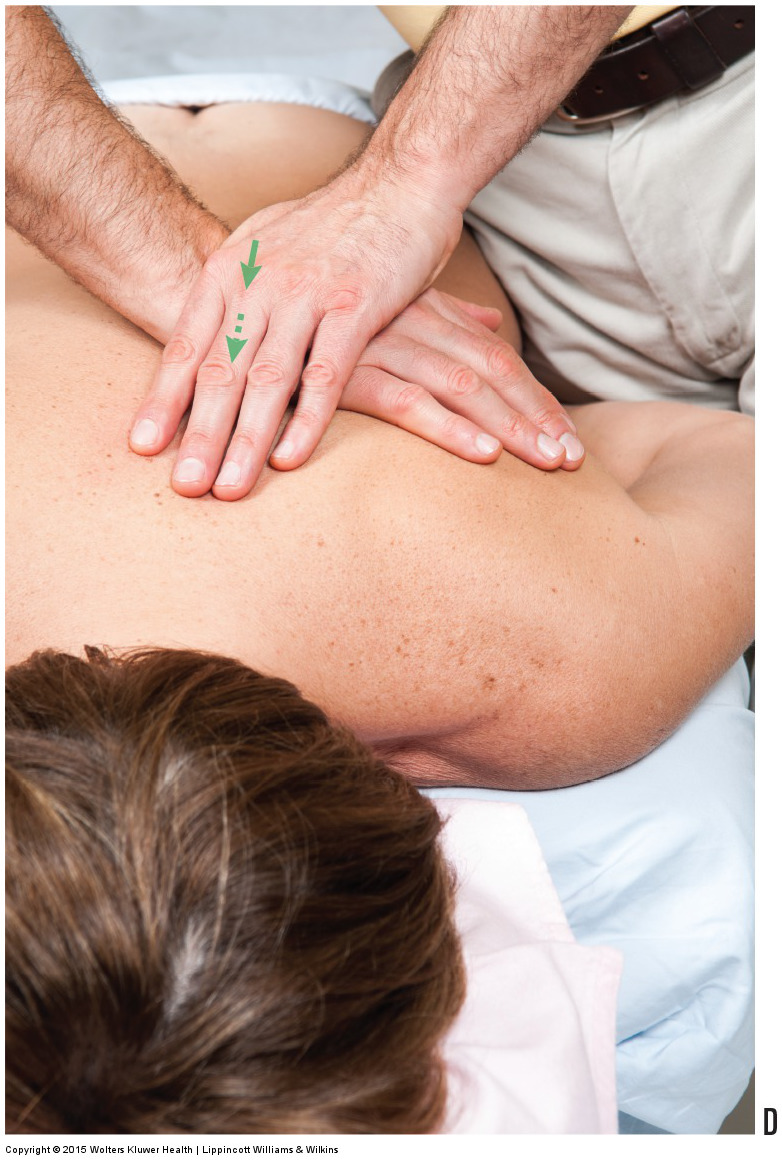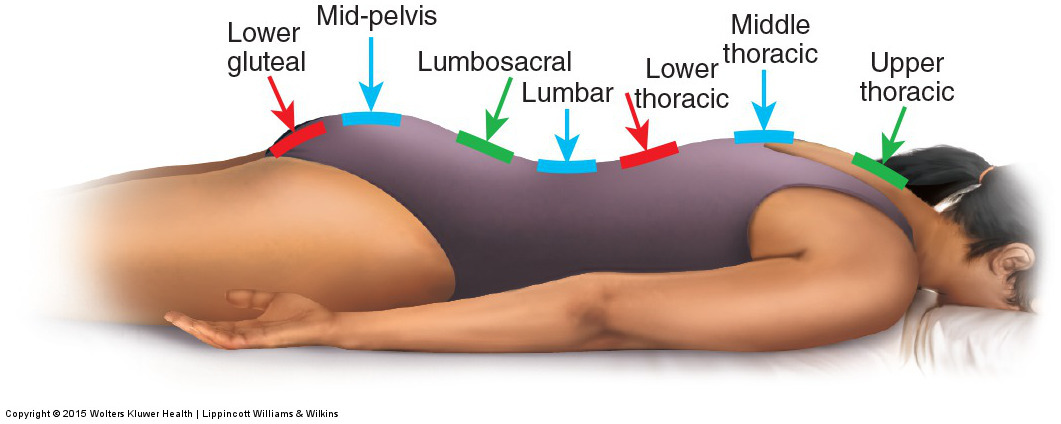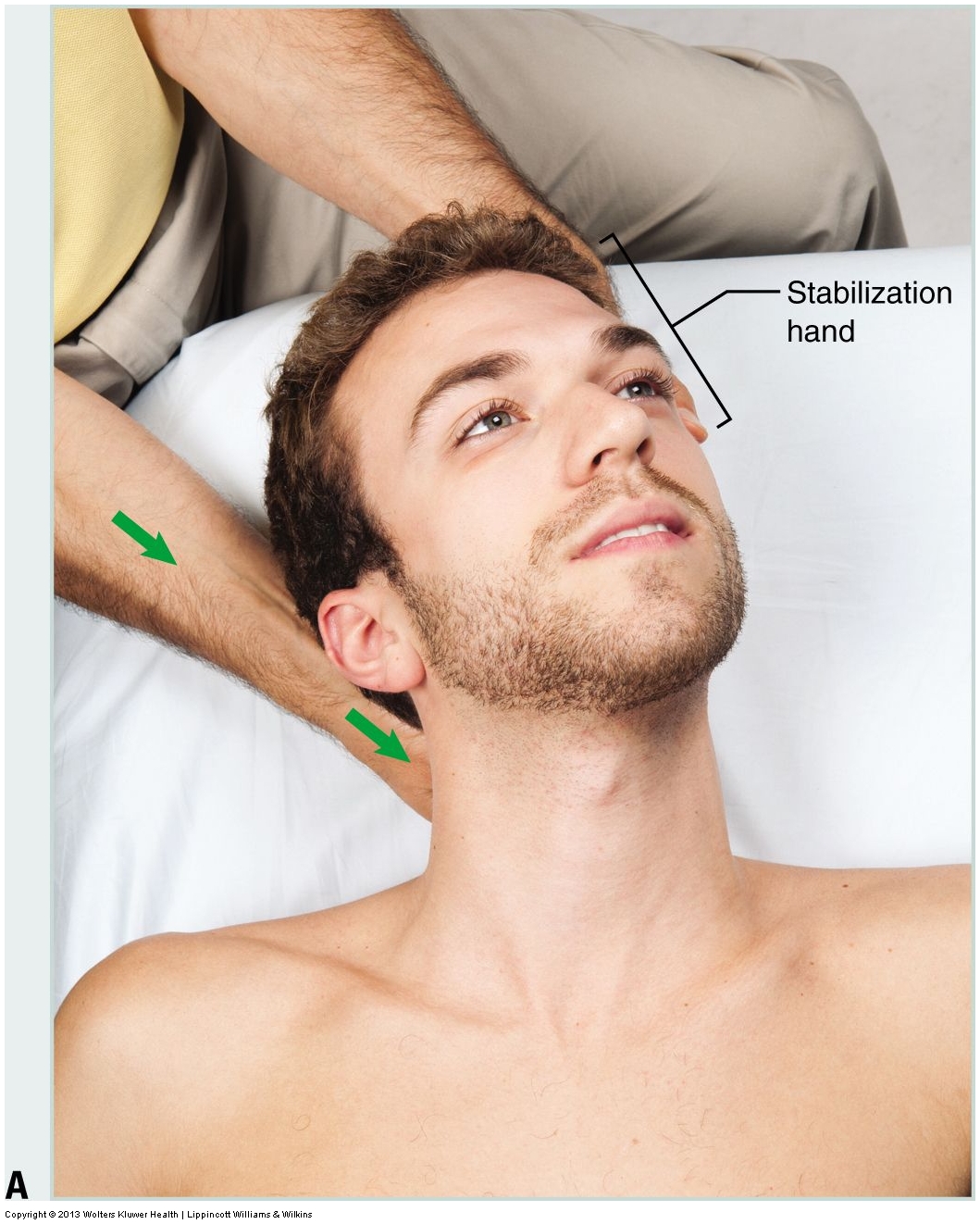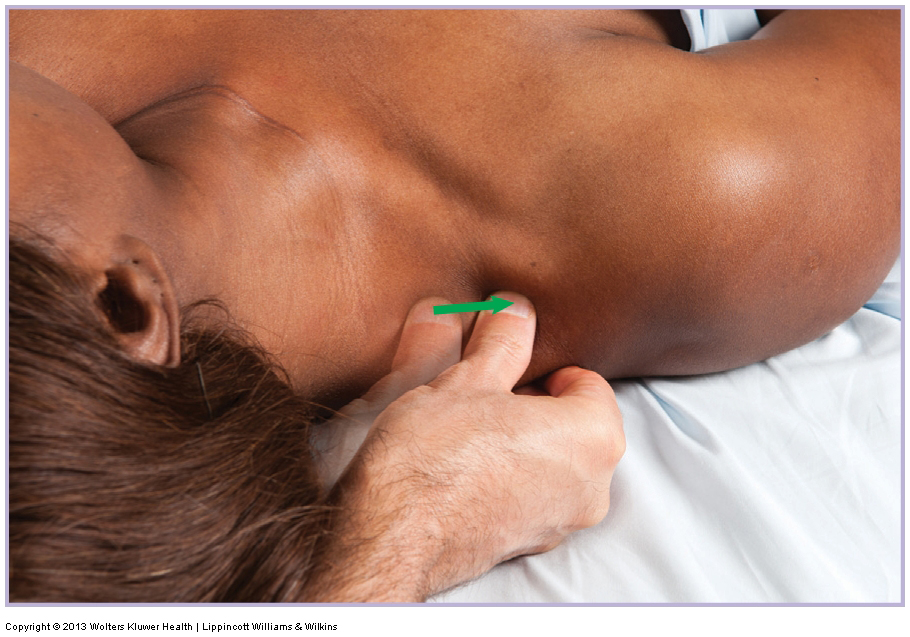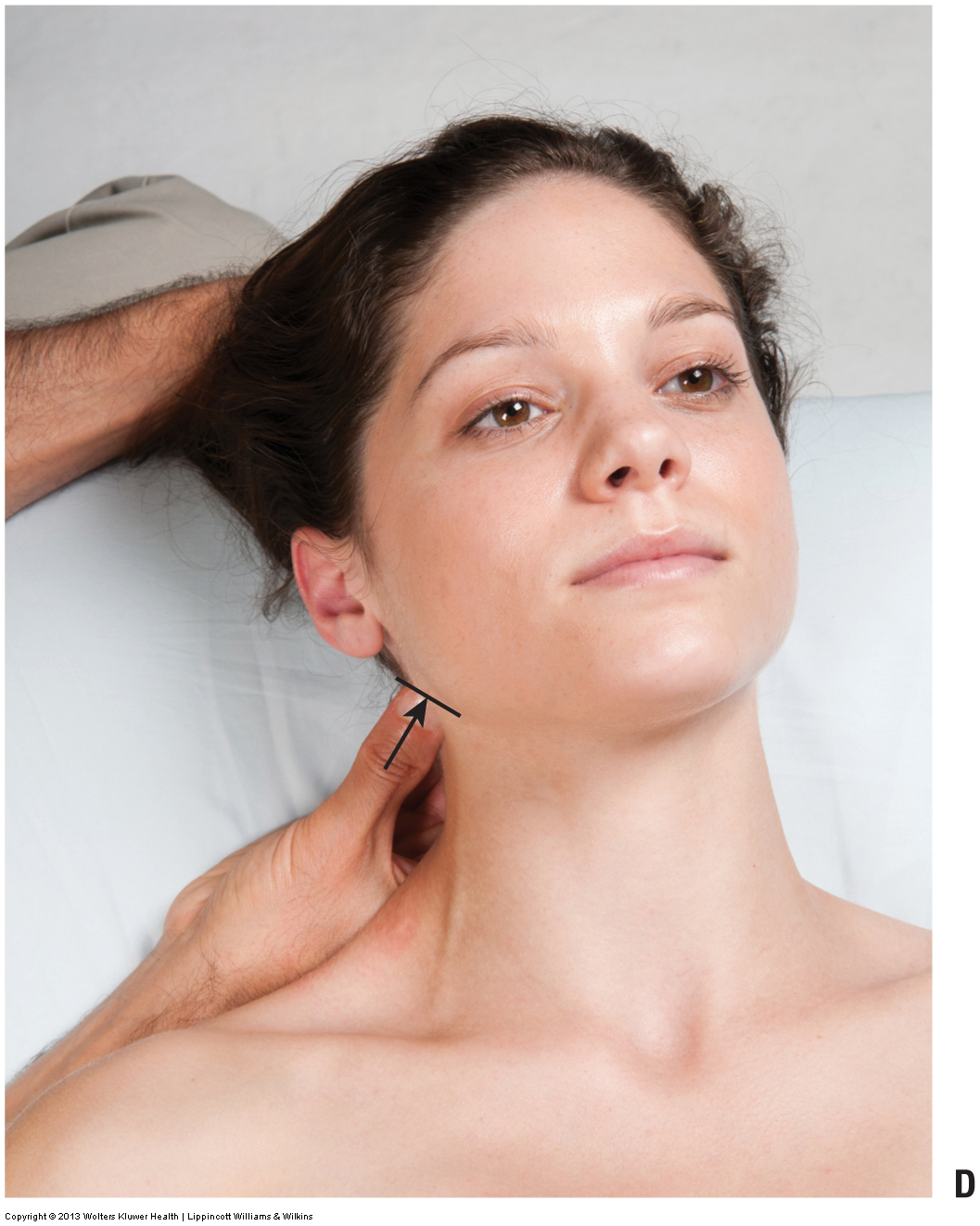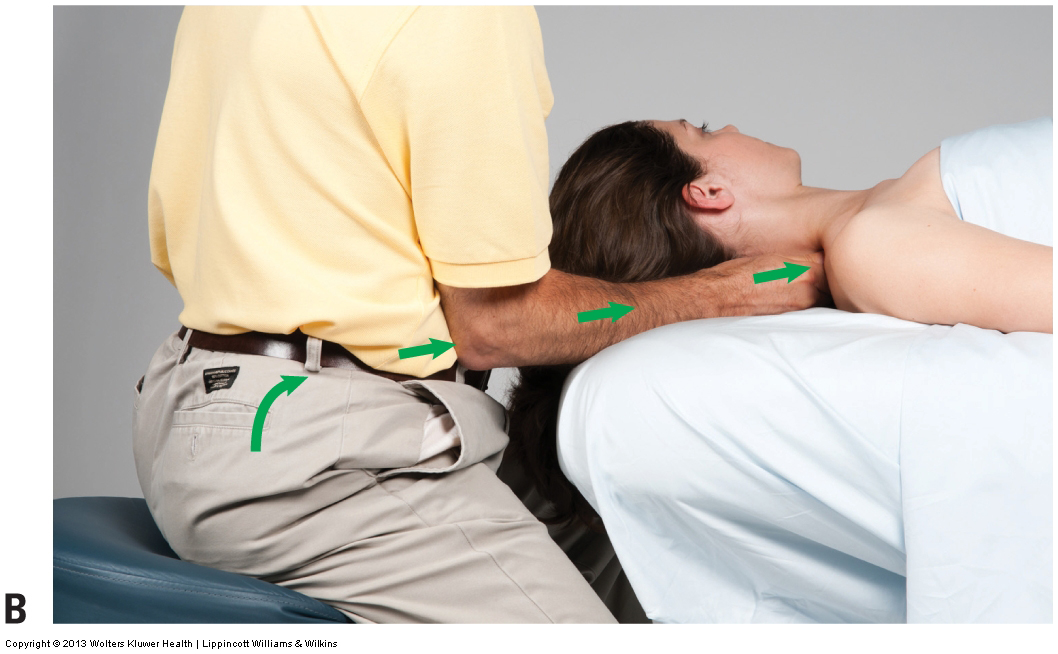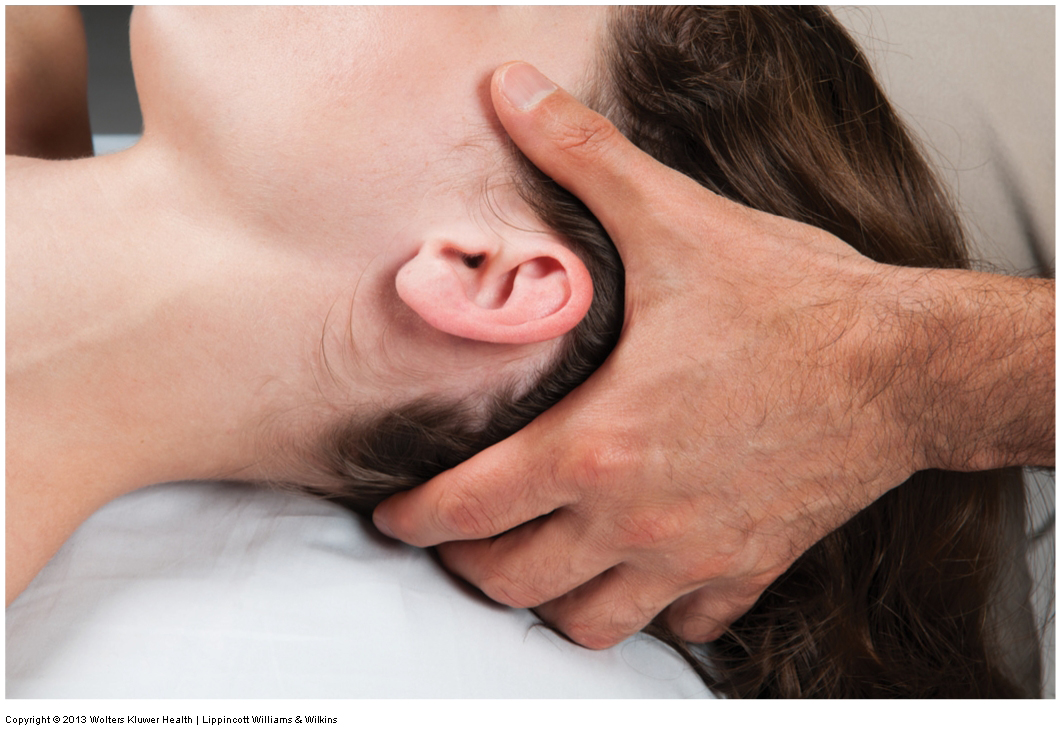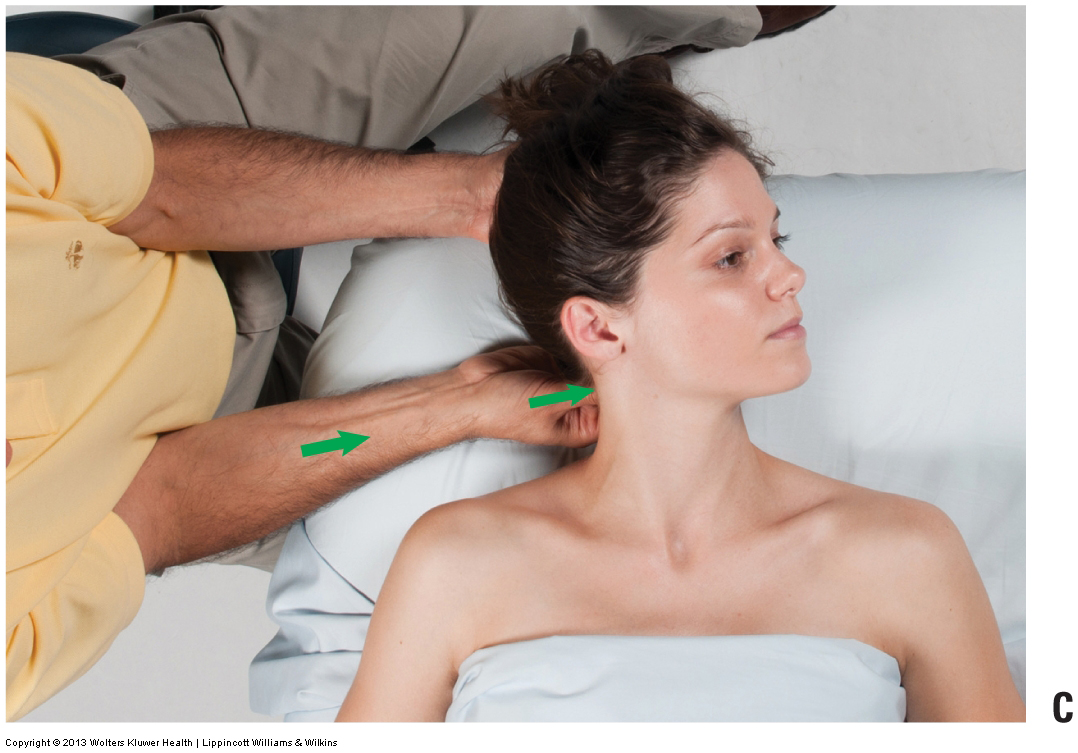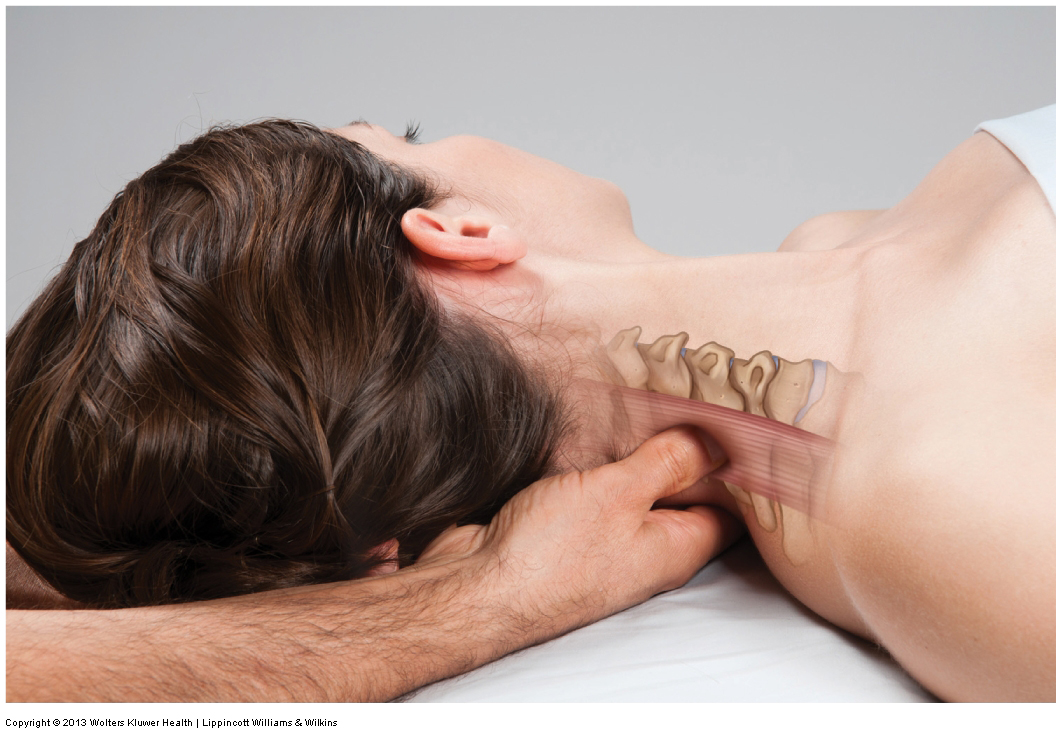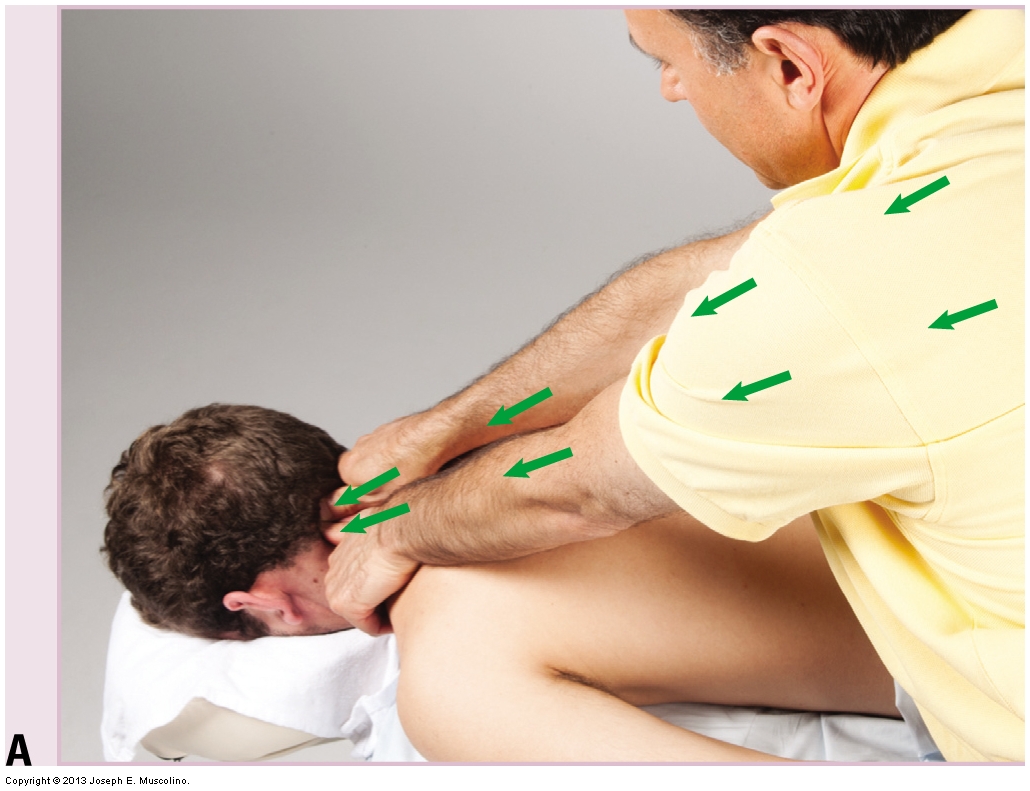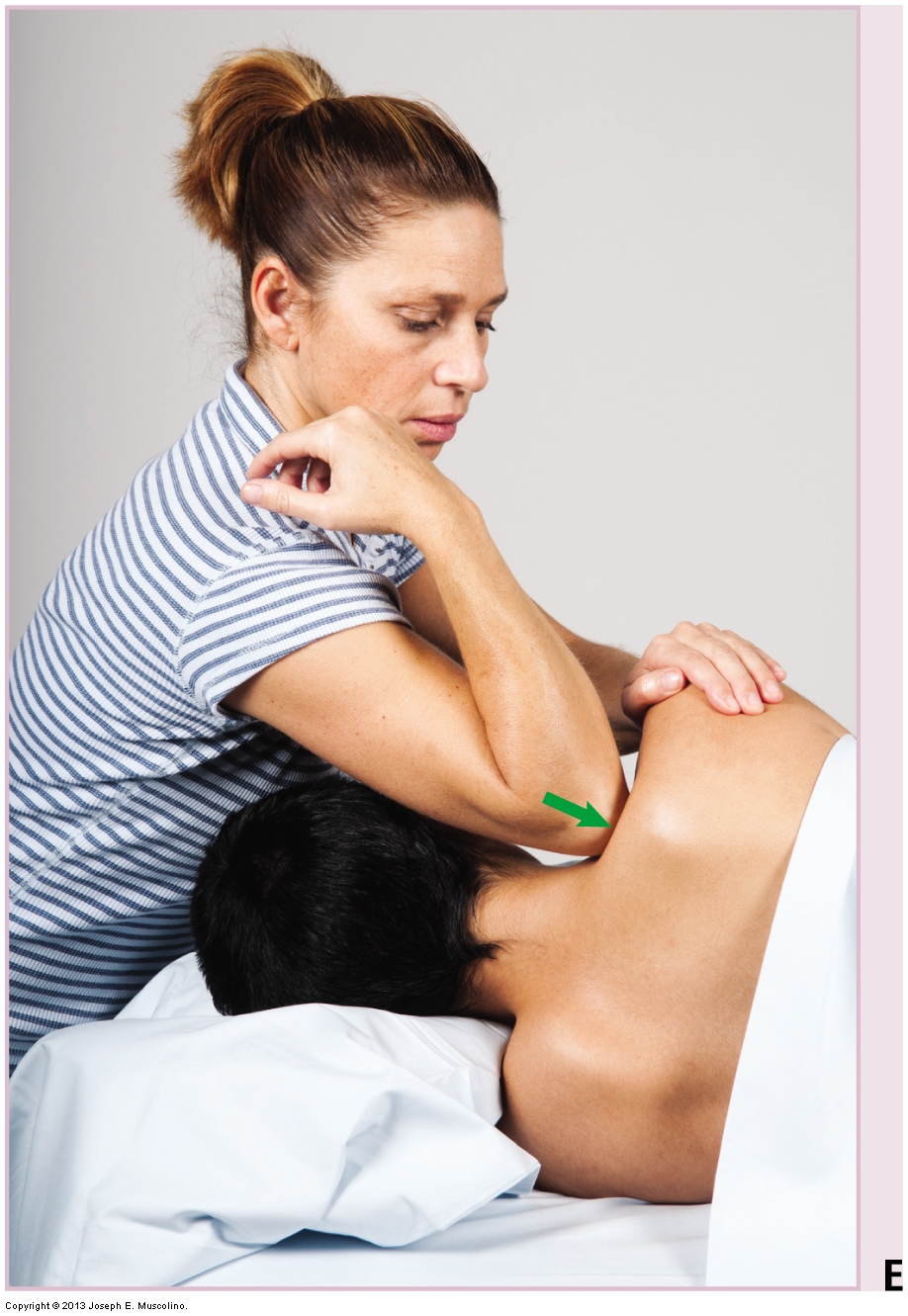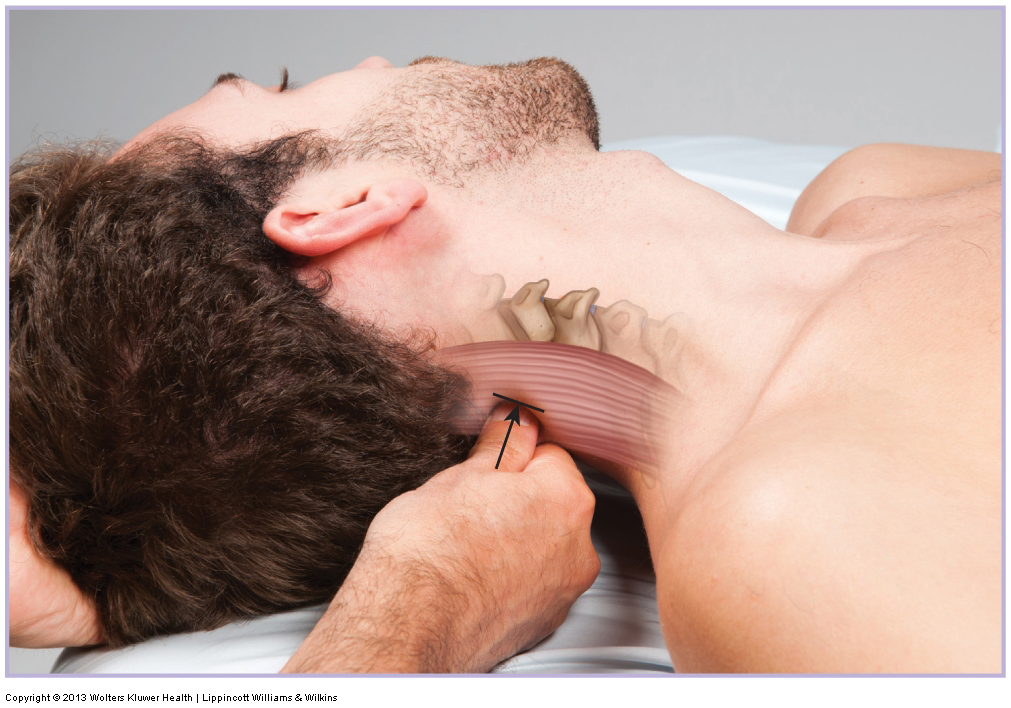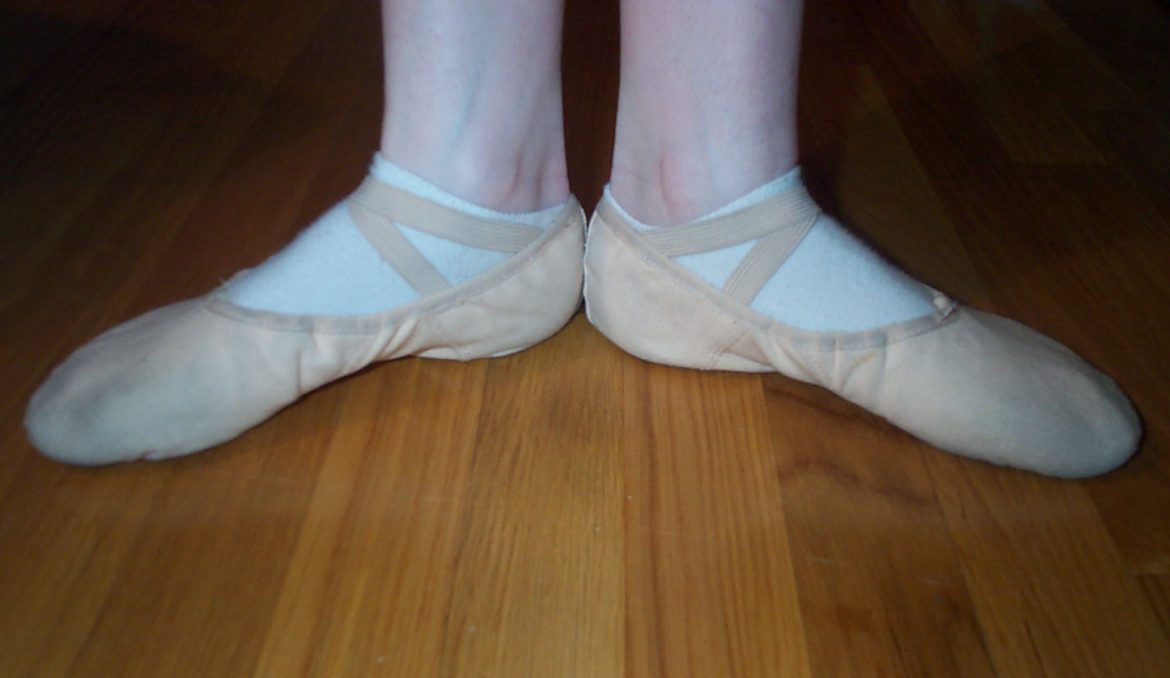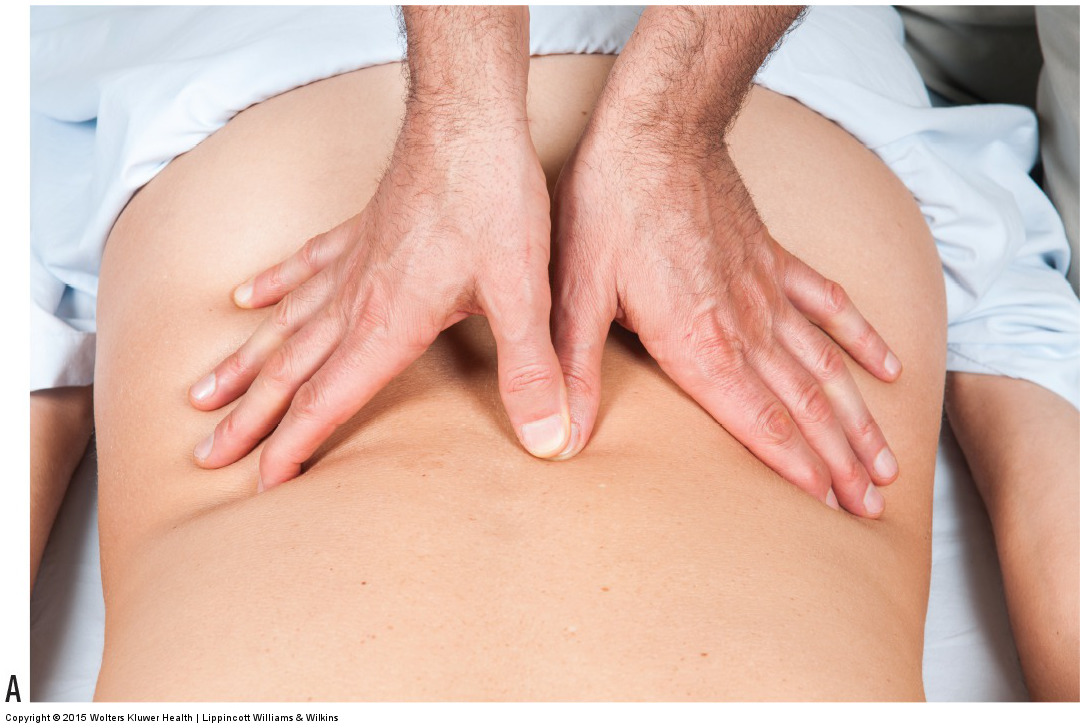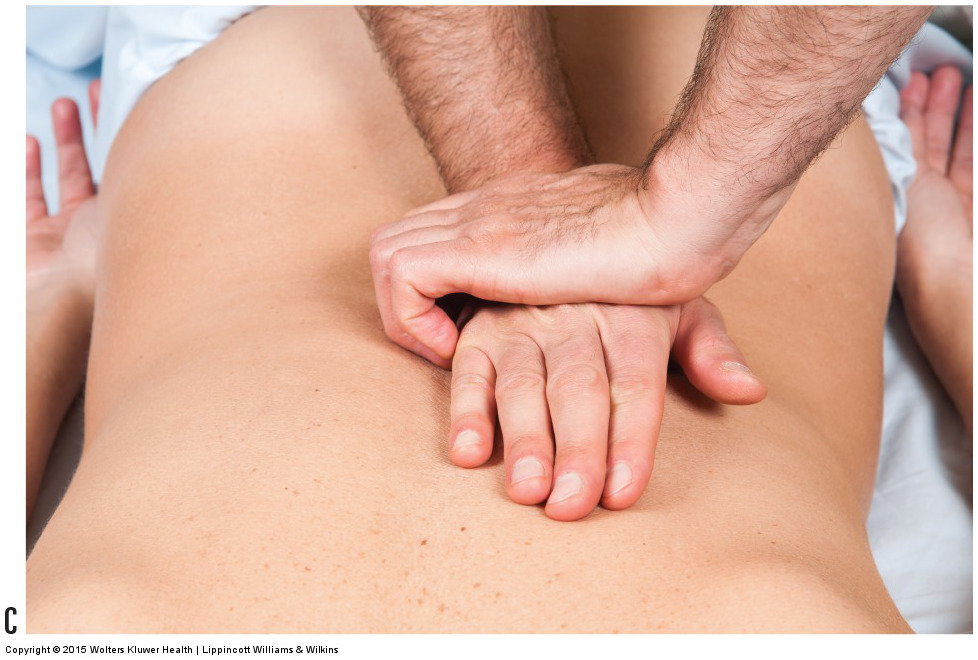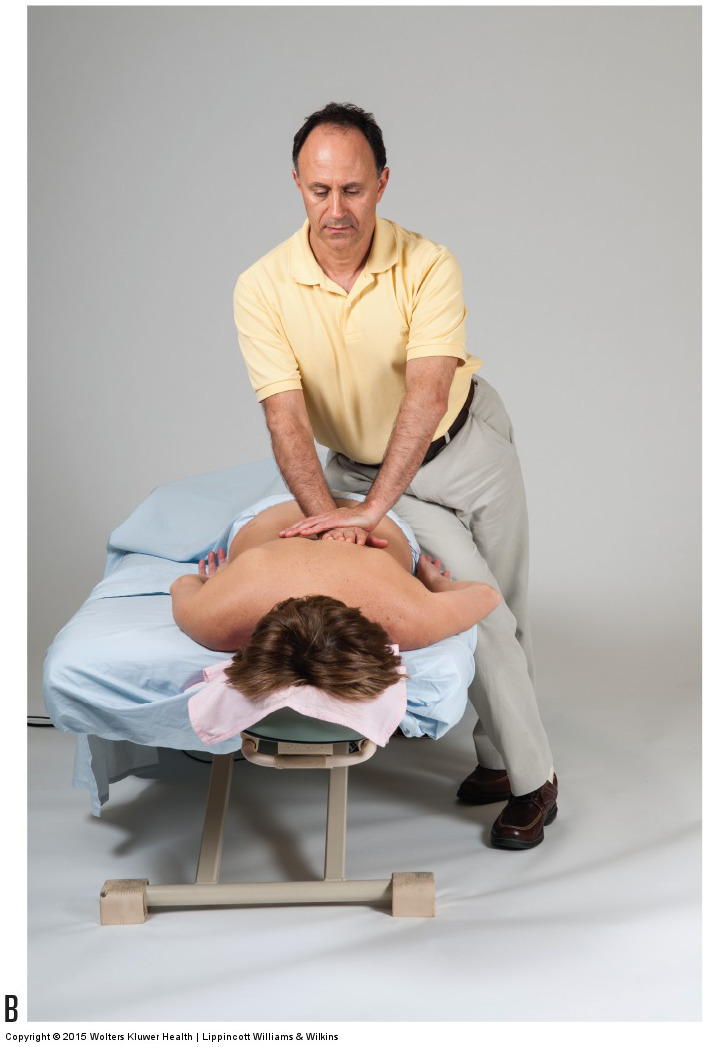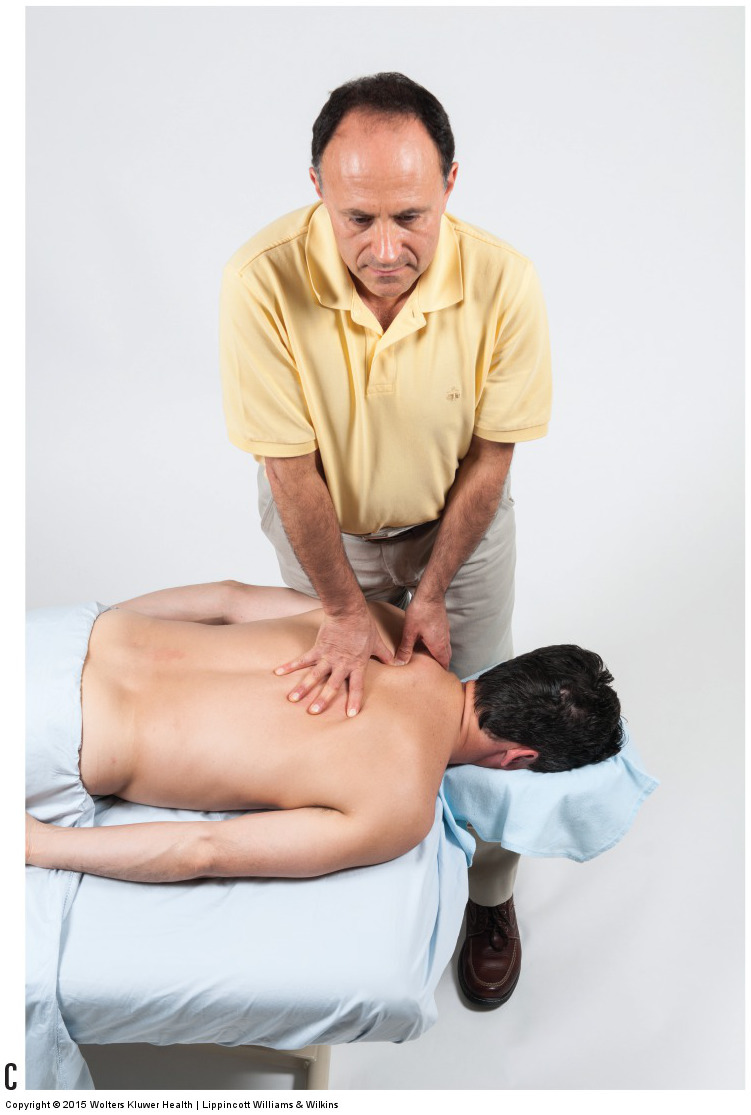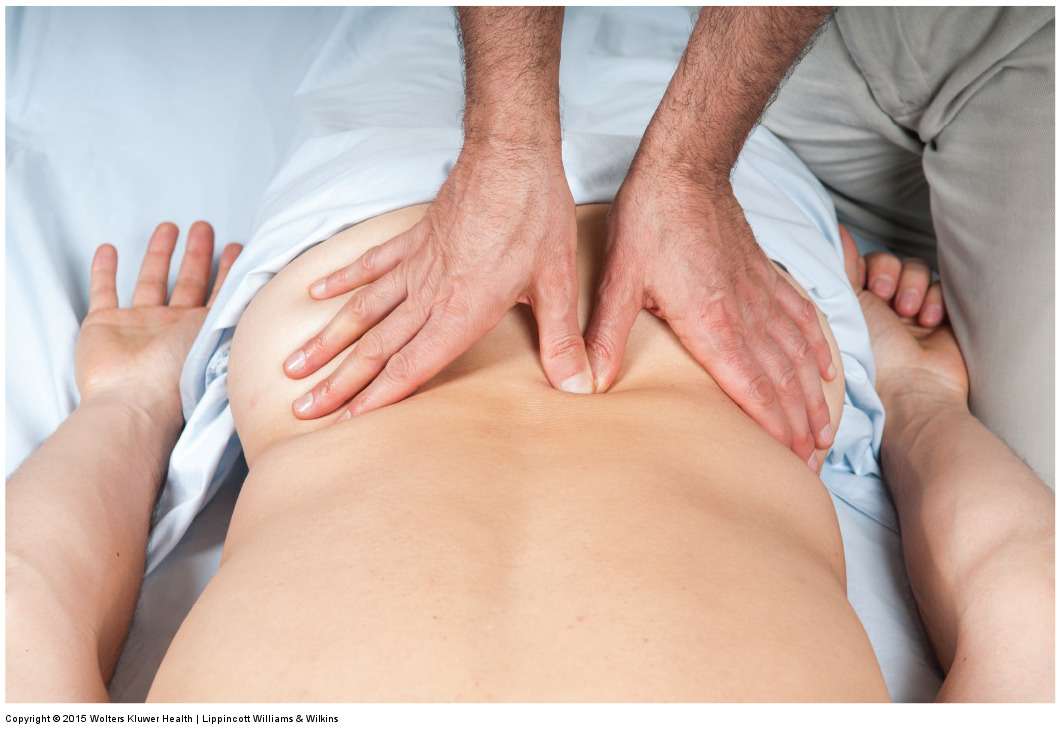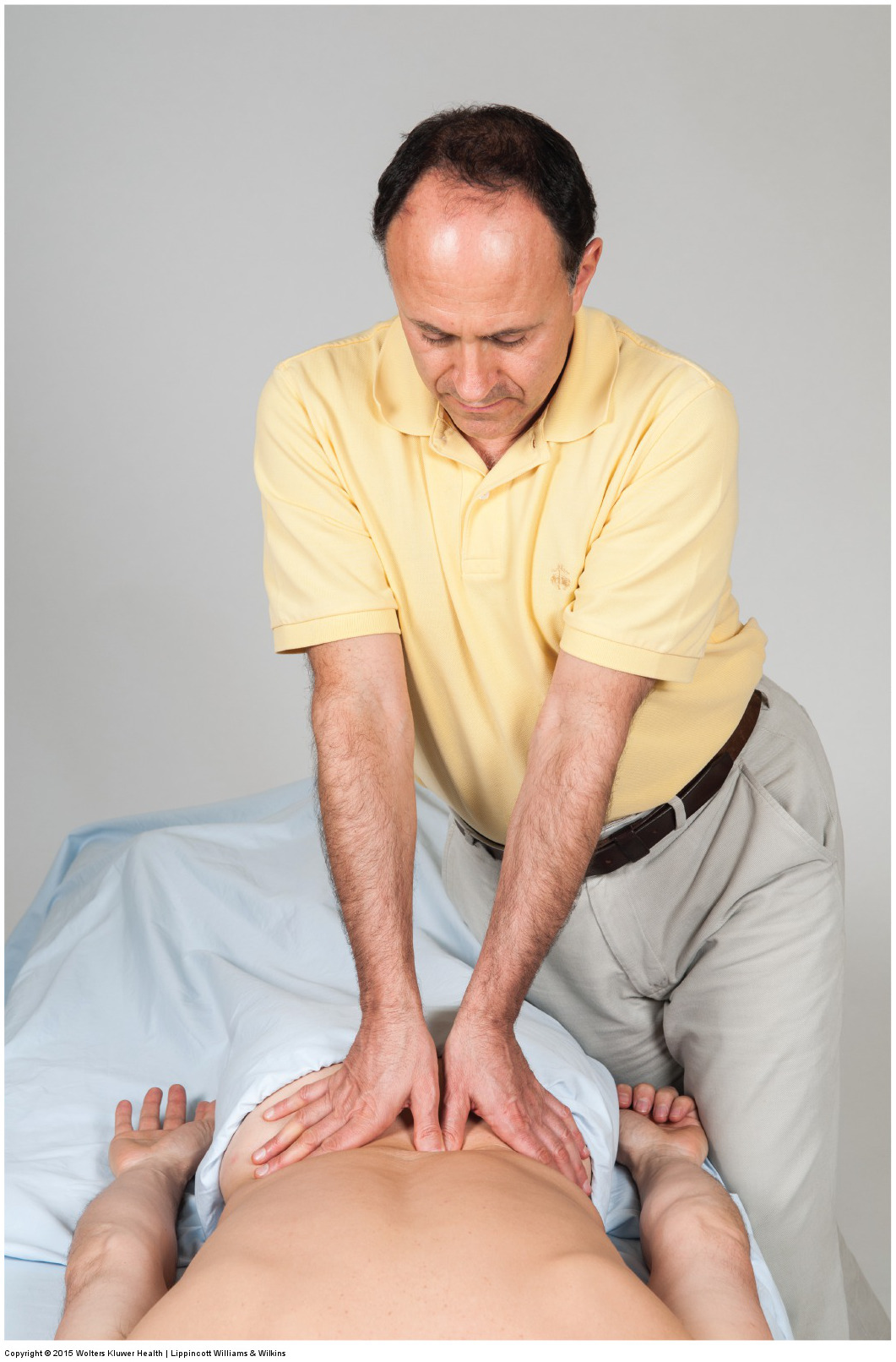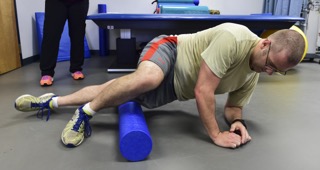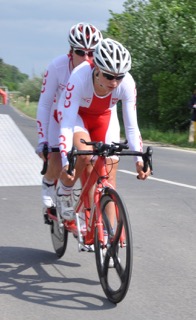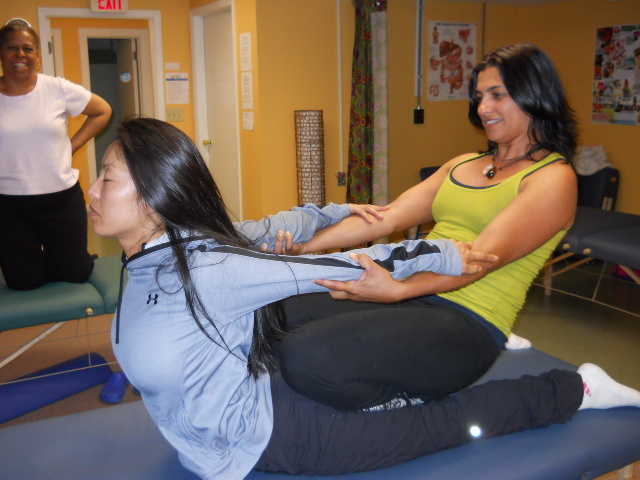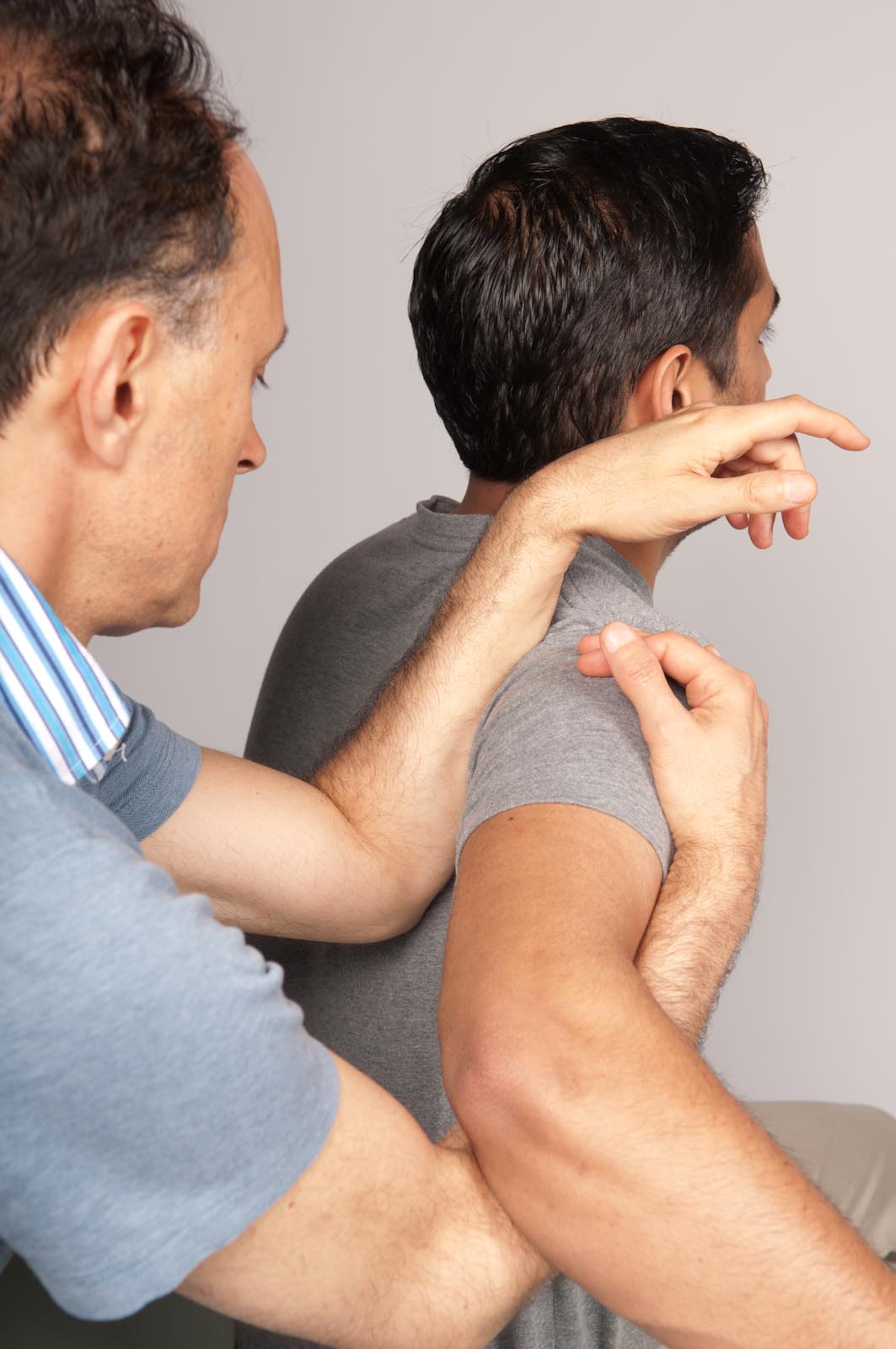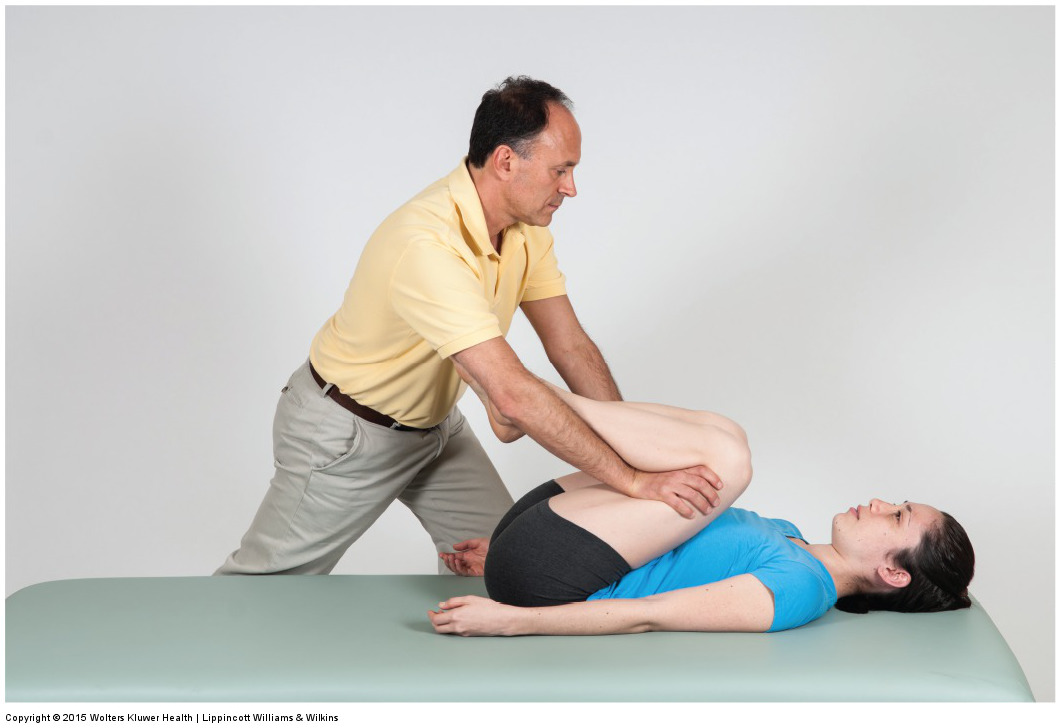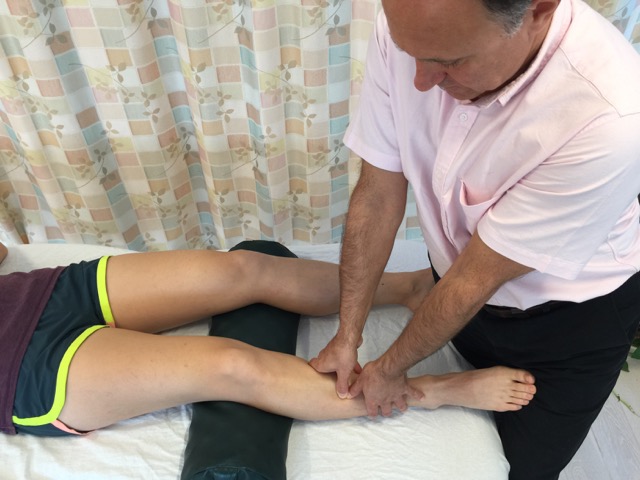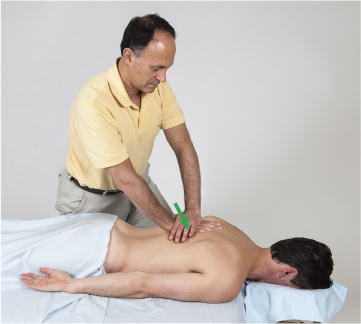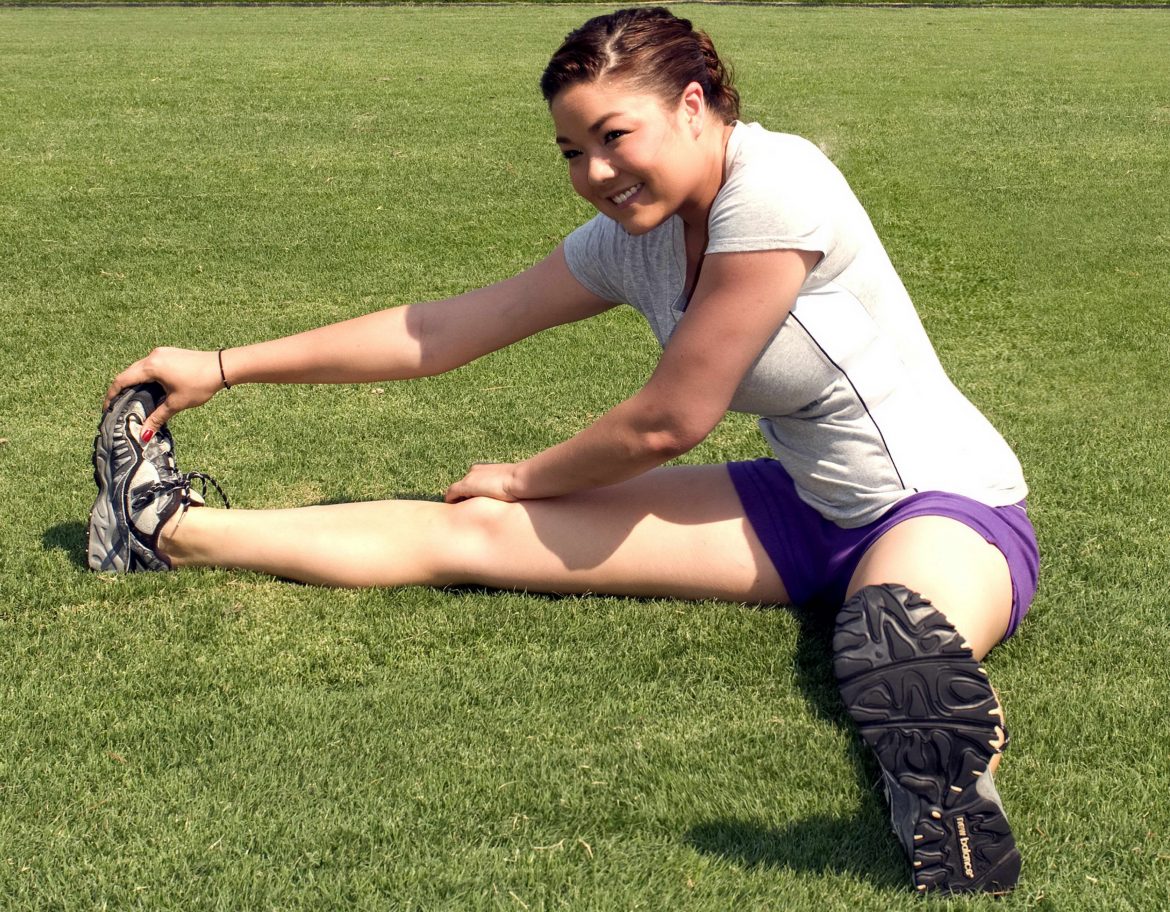To transition to perform deep strokes and maintain proper body mechanics, it is necessary to transition from being perpendicular to be slightly horizontal to glide along the client’s body. However, minimize the horizontal direction or pressure into the client’s tissues will be lost.
Deep Pressure Massage to the Low Back – Use Body Weight
An excellent demonstration of the force that can be generated by using body weight is to lean down onto a bathroom weight scale that is placed on a table that is positioned as various heights. Simply relax and lean into the scale with your body weight and notice the force that you generate.
Deep Pressure Massage to the Low Back – Use Stacked Joints
Stacked joints are aligned in a straight line; in other words, the joints are extended as in anatomic position. This allows for the force from your core to travel through your upper extremity and into the client with little or no loss of strength.
Deep Pressure Massage to the Low Back – Support Your Treatment Contact
Bracing the contact means that the two hands must work together instead of each contacting the client separately. Less area of the client’s body will be covered this way, but stronger and more efficient pressure will be created at the area that is being worked, which is more important when deep pressure is needed.
Deep Pressure Massage to the Low Back – Apply Pressure Perpendicularly
Maximal pressure for the effort used is achieved if the angle of your force into the client is perpendicular to the contour of the region being worked. To apply this concept of working perpendicularly, the client’s back and pelvis can be divided into separate regions based on the curve of each region.
Neck Deep Pressure Massage: Step by Step – Engage the Tissues
Being able to feel tissue tension barrier is the one most crucial aspect for a clinical orthopedic manual therapist performing deep pressure massage. From a mechanical standpoint, it is only pressure beyond the tissue tension barrier that effects therapeutic change (this is not necessarily true neurally).
Neck Deep Pressure Massage: Step by Step – Deep Stroking Massage
When performing deep pressure massage, deep stroking massage must originate from your core by further rocking your pelvis and extending your spine forward. Short deep strokes to the neck between 1 and 2 inches (2-5 centimeters) in length allow you to preserve optimal body mechanics.
Neck Deep Pressure Massage: Step by Step – Apply Pressure Perpendicularly
When performing deep pressure massage into the neck, maximal pressure for minimal effort is achieved if the angle of your pressure into the client is perpendicular to the contour of the neck where you are working.
Neck Deep Pressure Massage: Step by Step – Use Your Core
For deep pressure massage to the neck, align your core with your stroke by laterally (externally) rotating your arm at the shoulder joint so that your elbow is positioned in front of your core. Now lock your elbow into your core just inside (and usually slight above) your anterior superior iliac spine.
Neck Deep Pressure Massage: Step by Step – Contacts
Even perfect body mechanics cannot eliminate all physical stress to your body when doing massage. Ideal body mechanics merely minimize the stress. For this reason, when doing massage, especially deep pressure massage, it is wise to alternate which treatment hand contact you use during a session.
Neck Deep Pressure Massage: Step by Step – Positioning
When performing deep pressure massage for the neck with the client supine, it is typical for the therapist to sit, centered at the head of the table. However, this does not allow for efficient body mechanics because it is difficult or impossible to position your core in line with the stroke.
Neck Deep Pressure Massage: Overview
The science of performing deep tissue work to the neck follows the laws of physics and, whenever possible, involves the use of body weight and the contraction of larger muscles instead of smaller ones. The art of performing deep tissue work lies in exactly how these guidelines are carried out and applied.
Neck Deep Pressure Massage: Using Bodyweight and Muscular Effort
We can take advantage of our body weight to generate deep pressure massage into the client’s tissues by simply leaning into the client. Pressure derived this way is effectively free because it takes no effort on our part. For this reason, it should be used whenever possible.
Neck Deep Pressure Massage: Step by Step – Prone and Side-Lying
Side-lying position for deep pressure massage into the neck can be very effective and can allow for effective longitudinal as well as transverse cross-fiber strokes; however, it is important to avoid exerting deep pressure too far anteriorly onto the transverse processes of the client’s neck.
Introduction to Deep Pressure Massage Technique for the Neck
Force for deep pressure can be generated in two ways: externally or internally. The external generation of force comes from the force of gravity by using our body weight. The internal generation of force comes from the contraction of our muscles.
The Effect of Myofascial Manipulation on Turnout in Classical Dance
The study demonstrated that four sessions of MFR of the lower limb can induce an improvement in the isolated external hip joint rotation. The authors hypothesized that the improvement in the hip joint’s ROM was due to reduced myofascial stiffness after the MFR treatments.
Deep Pressure Massage to the Low Back – Tissue Tension Barrier
Being able to feel tissue tension barriers is the one most important hands-on skill that an orthopedic manual therapist needs. Clinical orthopedic manual therapy (massage and stretching) only effects change if we reach tissue tension and then apply slightly more force beyond it.
Deep Pressure Massage to the Low Back – Choosing the Treatment Contact
When working the low back, a good strategy is to begin with a smaller treatment contact such as thumb or finger pads to assess and begin treatment of the lumbar region, and then switch to a larger contact such as the palm or elbow to deliver deeper pressure.
Deep Pressure Massage to the Low Back – Positioning the Feet
Make sure that the feet are not too far apart. A wide stance may feel more stable but creates a static position that makes it difficult to transfer weight from one foot to the other. With a narrower stance, it is easier to shift the center of weight of the body from one foot to the other as a stroke is done.
Deep Pressure Massage to the Low Back – Client and Therapist Positioning
A common body mechanics error is for the therapist to stand above the face cradle at the head end of the table. Standing here only distances you from the client, causing you to lean over the client to reach the low back; this compromises body mechanics and does not allow for the efficient use of body weight.
Body Mechanics for Deep Pressure Massage to the Low Back – Overview
For proper body mechanics, it is important to support your contact. Place the thumb pad of your right hand over the thumb pad contact of the left hand to brace/support it. Proper location of the brace is to place the right thumb pad on the dorsal surface of the distal phalanx of the thumb.
Deep Pressure Massage to the Low Back – Choosing the Right Table
Even more important than table width is table height. As a rule, when generating deep pressure, you want the table to be as low as possible so that you can more easily position your body above the client to take advantage of gravity and body weight.
Foam Rolling the Posterior Leg Decreases Spinal Excitability of the Soleus
This study showed evidence that foam rolling induced modulation of spinal nervous system excitability (in other words, change in the sensitivity of the muscle spindle reflex).
Massage Therapy Improves Training of Elite Para-Athletes
The results showed that massage therapy afforded significant improvement for sleep, muscle tone (tightness), and recovery from workout while in training for paracyclists.
Manual Therapy Case Study for Upper Crossed Syndrome
The therapist performed a static assessment of the client’s posture and noted the typical upper crossed syndrome with a hyperkyphotic thoracic spine, a hypolordotic lower cervical spine, a hyperlordotic upper cervical spine, protracted head, protracted scapulae, and medially (internally) rotated arms.
How do we Treat Upper Crossed Syndrome with Manual Therapy?
Especially effective for the pectoralis musculature is to use pin and stretch technique. With the client/patient supine and positioned toward the side of the table, pin the musculature with your finger pads as you bring the client/patient’s abducted arm off the side of the table and down into horizontal extension.
How do we treat sciatica with manual therapy?
It is necessary to determine what condition is causing the sciatic nerve compression and address that. If the cause is a pathologic disc, then addressing factors that affect disc compression is appropriate.
How do we treat shin splints with manual therapy?
The first goal of manual therapy treatment for shin splints is to relieve the tension of the involved musculature by lessening baseline muscle tone and eliminating any trigger points that might be present. The second goal is to treat swelling, if present.
How Do We Treat Slumped Spinal Posture with Manual Therapy?
When performing soft tissue manipulation/massage, it is always wise to begin with light to medium pressure, and then transition to deeper pressure.
Self-Massage Before Stretching Improves Stretching Outcomes
This study validates the efficacy of performing massage before stretching our clients, and recommending self-massage before stretching for client self-care.

